HE20510 - Assessment Event 2 Essay: Inclusive Programs in Childcare
VerifiedAdded on 2023/04/24
|9
|2115
|323
Essay
AI Summary
This essay explores the concept of inclusive practices in early childhood education within the Australian context. It emphasizes the importance of creating educational environments that eliminate barriers and provide diverse learning opportunities for all children, including those with disabilities. The essay delves into the benefits of inclusive education, such as fostering a sense of belonging, promoting social development, and preparing children for community life. It also examines the roles of educators, families, and administrators in implementing successful inclusive programs, highlighting the need for specialized training, supportive environments, and collaborative partnerships. The essay further discusses practical strategies for creating inclusive classrooms, including adapting physical spaces, utilizing visual resources, and promoting positive attitudes towards children with special needs. The significance of partnership between educators, support professionals and family members is also discussed for maximizing the learning potential of children. The essay concludes by reiterating the value of inclusive education in providing equal opportunities and laying a foundation for children's future success.
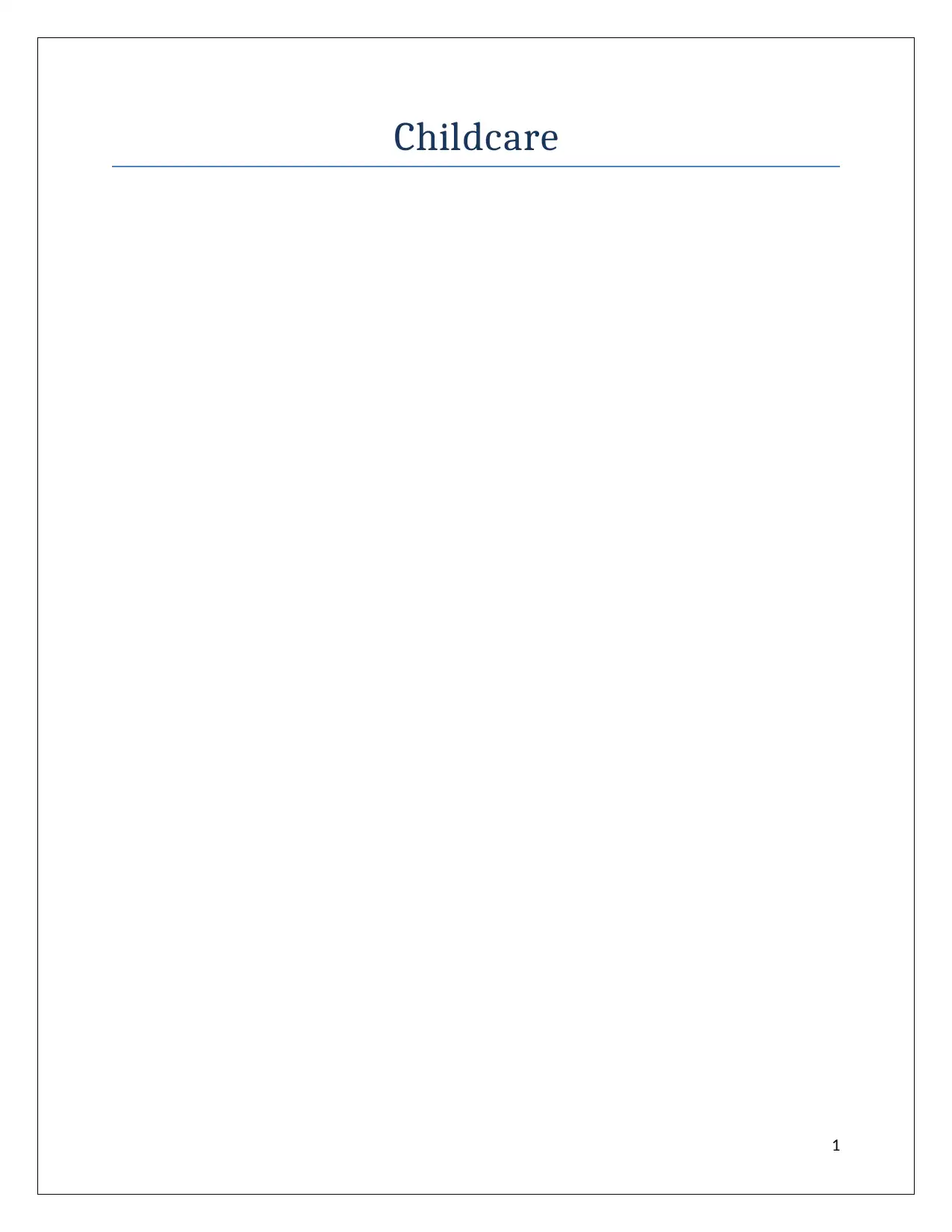
Childcare
1
1
Paraphrase This Document
Need a fresh take? Get an instant paraphrase of this document with our AI Paraphraser
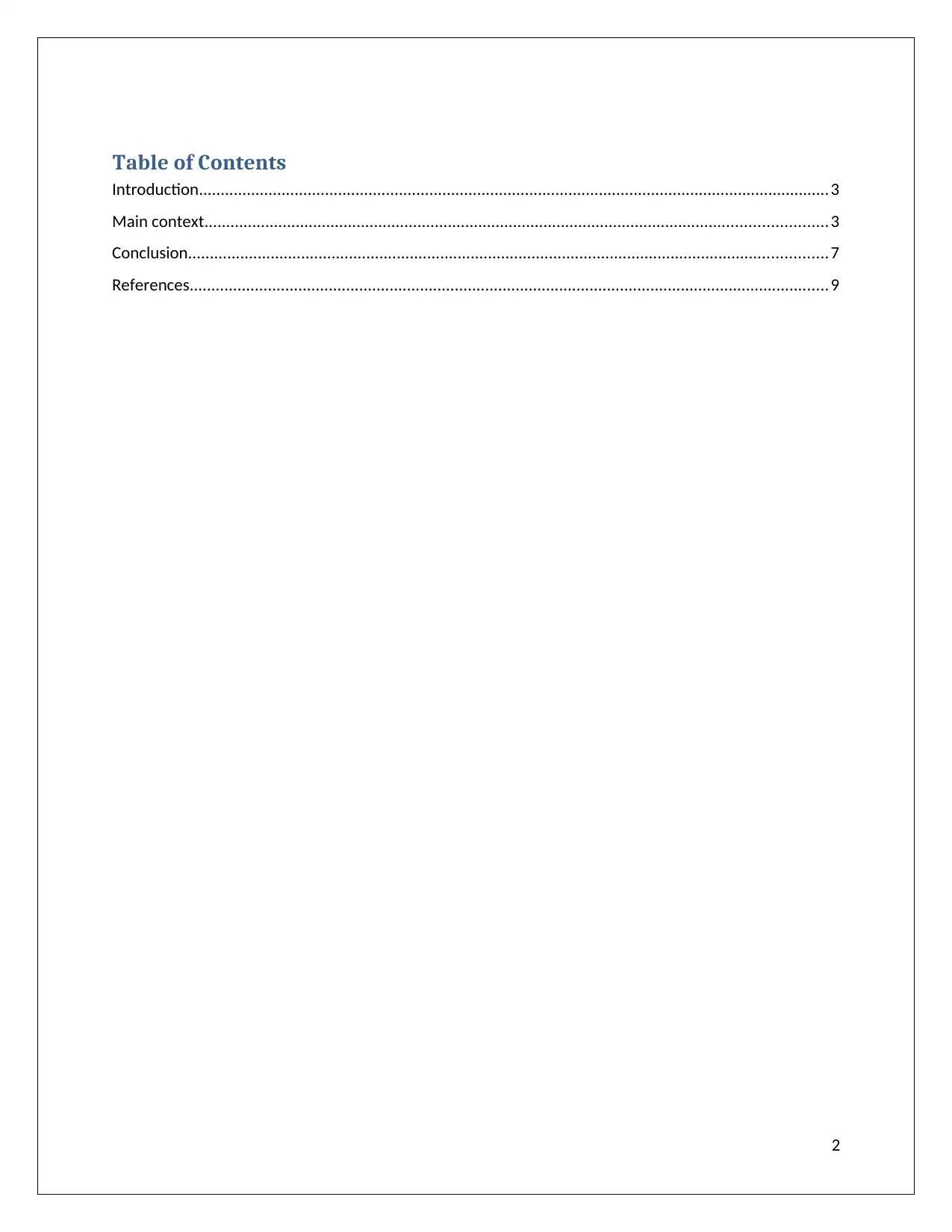
Table of Contents
Introduction.................................................................................................................................................3
Main context...............................................................................................................................................3
Conclusion...................................................................................................................................................7
References...................................................................................................................................................9
2
Introduction.................................................................................................................................................3
Main context...............................................................................................................................................3
Conclusion...................................................................................................................................................7
References...................................................................................................................................................9
2
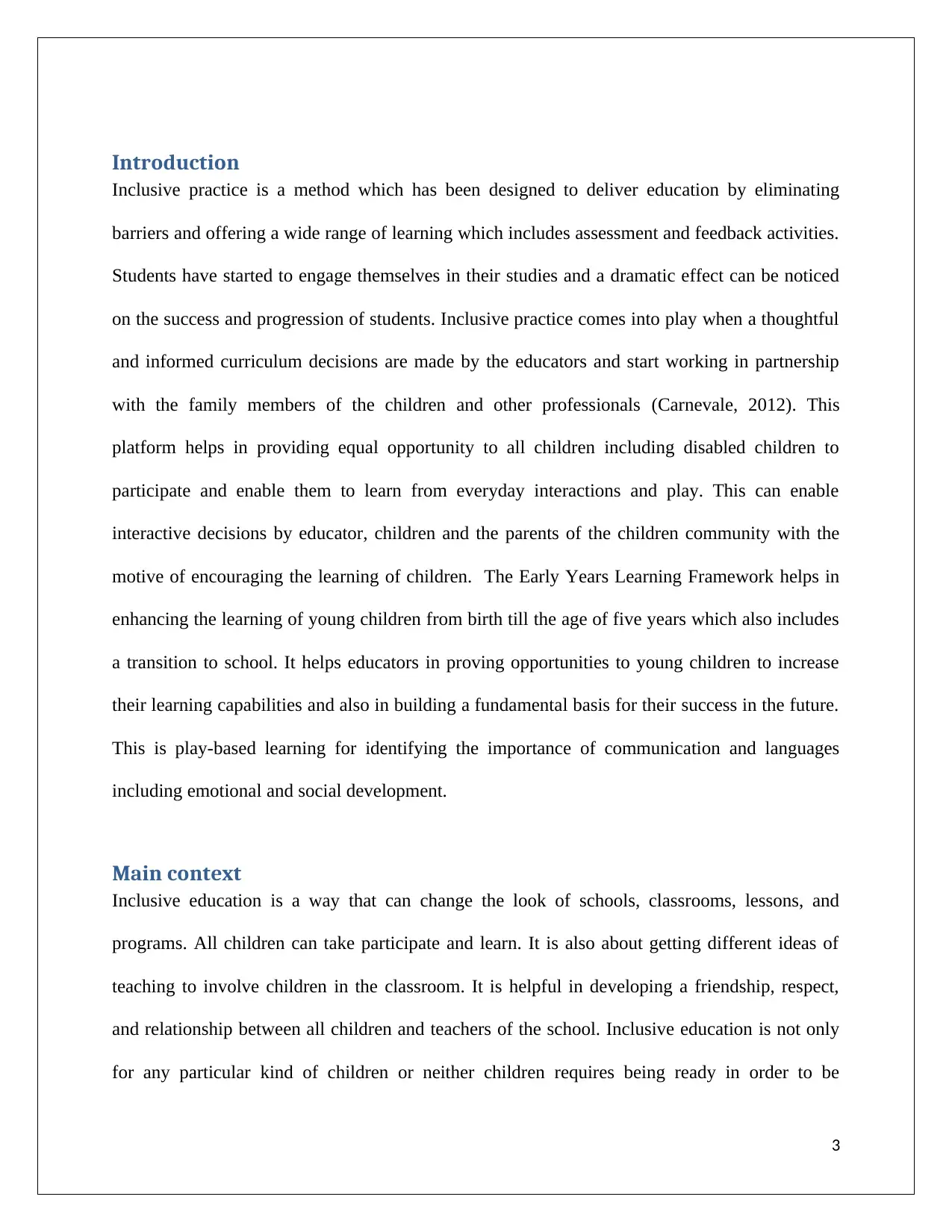
Introduction
Inclusive practice is a method which has been designed to deliver education by eliminating
barriers and offering a wide range of learning which includes assessment and feedback activities.
Students have started to engage themselves in their studies and a dramatic effect can be noticed
on the success and progression of students. Inclusive practice comes into play when a thoughtful
and informed curriculum decisions are made by the educators and start working in partnership
with the family members of the children and other professionals (Carnevale, 2012). This
platform helps in providing equal opportunity to all children including disabled children to
participate and enable them to learn from everyday interactions and play. This can enable
interactive decisions by educator, children and the parents of the children community with the
motive of encouraging the learning of children. The Early Years Learning Framework helps in
enhancing the learning of young children from birth till the age of five years which also includes
a transition to school. It helps educators in proving opportunities to young children to increase
their learning capabilities and also in building a fundamental basis for their success in the future.
This is play-based learning for identifying the importance of communication and languages
including emotional and social development.
Main context
Inclusive education is a way that can change the look of schools, classrooms, lessons, and
programs. All children can take participate and learn. It is also about getting different ideas of
teaching to involve children in the classroom. It is helpful in developing a friendship, respect,
and relationship between all children and teachers of the school. Inclusive education is not only
for any particular kind of children or neither children requires being ready in order to be
3
Inclusive practice is a method which has been designed to deliver education by eliminating
barriers and offering a wide range of learning which includes assessment and feedback activities.
Students have started to engage themselves in their studies and a dramatic effect can be noticed
on the success and progression of students. Inclusive practice comes into play when a thoughtful
and informed curriculum decisions are made by the educators and start working in partnership
with the family members of the children and other professionals (Carnevale, 2012). This
platform helps in providing equal opportunity to all children including disabled children to
participate and enable them to learn from everyday interactions and play. This can enable
interactive decisions by educator, children and the parents of the children community with the
motive of encouraging the learning of children. The Early Years Learning Framework helps in
enhancing the learning of young children from birth till the age of five years which also includes
a transition to school. It helps educators in proving opportunities to young children to increase
their learning capabilities and also in building a fundamental basis for their success in the future.
This is play-based learning for identifying the importance of communication and languages
including emotional and social development.
Main context
Inclusive education is a way that can change the look of schools, classrooms, lessons, and
programs. All children can take participate and learn. It is also about getting different ideas of
teaching to involve children in the classroom. It is helpful in developing a friendship, respect,
and relationship between all children and teachers of the school. Inclusive education is not only
for any particular kind of children or neither children requires being ready in order to be
3
⊘ This is a preview!⊘
Do you want full access?
Subscribe today to unlock all pages.

Trusted by 1+ million students worldwide
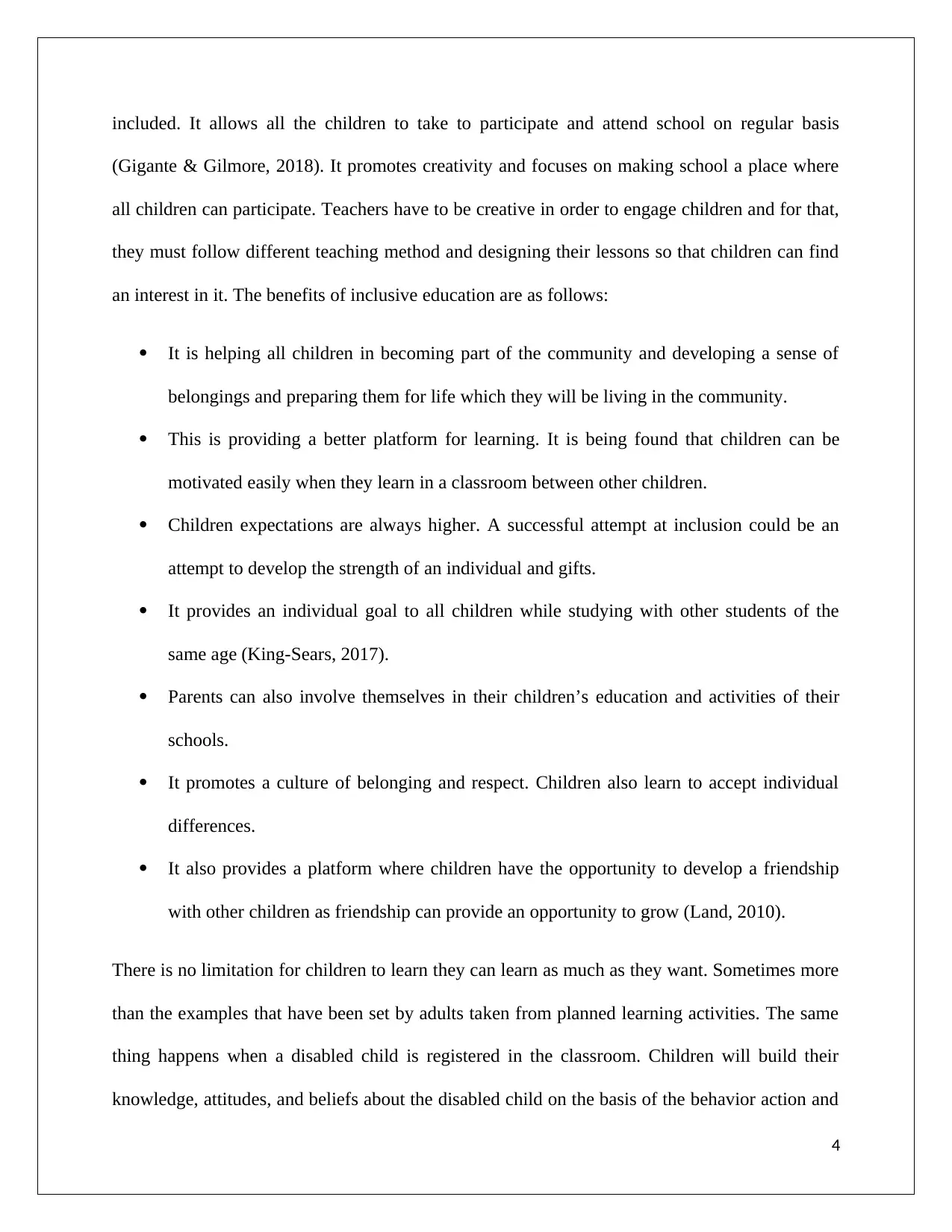
included. It allows all the children to take to participate and attend school on regular basis
(Gigante & Gilmore, 2018). It promotes creativity and focuses on making school a place where
all children can participate. Teachers have to be creative in order to engage children and for that,
they must follow different teaching method and designing their lessons so that children can find
an interest in it. The benefits of inclusive education are as follows:
It is helping all children in becoming part of the community and developing a sense of
belongings and preparing them for life which they will be living in the community.
This is providing a better platform for learning. It is being found that children can be
motivated easily when they learn in a classroom between other children.
Children expectations are always higher. A successful attempt at inclusion could be an
attempt to develop the strength of an individual and gifts.
It provides an individual goal to all children while studying with other students of the
same age (King-Sears, 2017).
Parents can also involve themselves in their children’s education and activities of their
schools.
It promotes a culture of belonging and respect. Children also learn to accept individual
differences.
It also provides a platform where children have the opportunity to develop a friendship
with other children as friendship can provide an opportunity to grow (Land, 2010).
There is no limitation for children to learn they can learn as much as they want. Sometimes more
than the examples that have been set by adults taken from planned learning activities. The same
thing happens when a disabled child is registered in the classroom. Children will build their
knowledge, attitudes, and beliefs about the disabled child on the basis of the behavior action and
4
(Gigante & Gilmore, 2018). It promotes creativity and focuses on making school a place where
all children can participate. Teachers have to be creative in order to engage children and for that,
they must follow different teaching method and designing their lessons so that children can find
an interest in it. The benefits of inclusive education are as follows:
It is helping all children in becoming part of the community and developing a sense of
belongings and preparing them for life which they will be living in the community.
This is providing a better platform for learning. It is being found that children can be
motivated easily when they learn in a classroom between other children.
Children expectations are always higher. A successful attempt at inclusion could be an
attempt to develop the strength of an individual and gifts.
It provides an individual goal to all children while studying with other students of the
same age (King-Sears, 2017).
Parents can also involve themselves in their children’s education and activities of their
schools.
It promotes a culture of belonging and respect. Children also learn to accept individual
differences.
It also provides a platform where children have the opportunity to develop a friendship
with other children as friendship can provide an opportunity to grow (Land, 2010).
There is no limitation for children to learn they can learn as much as they want. Sometimes more
than the examples that have been set by adults taken from planned learning activities. The same
thing happens when a disabled child is registered in the classroom. Children will build their
knowledge, attitudes, and beliefs about the disabled child on the basis of the behavior action and
4
Paraphrase This Document
Need a fresh take? Get an instant paraphrase of this document with our AI Paraphraser
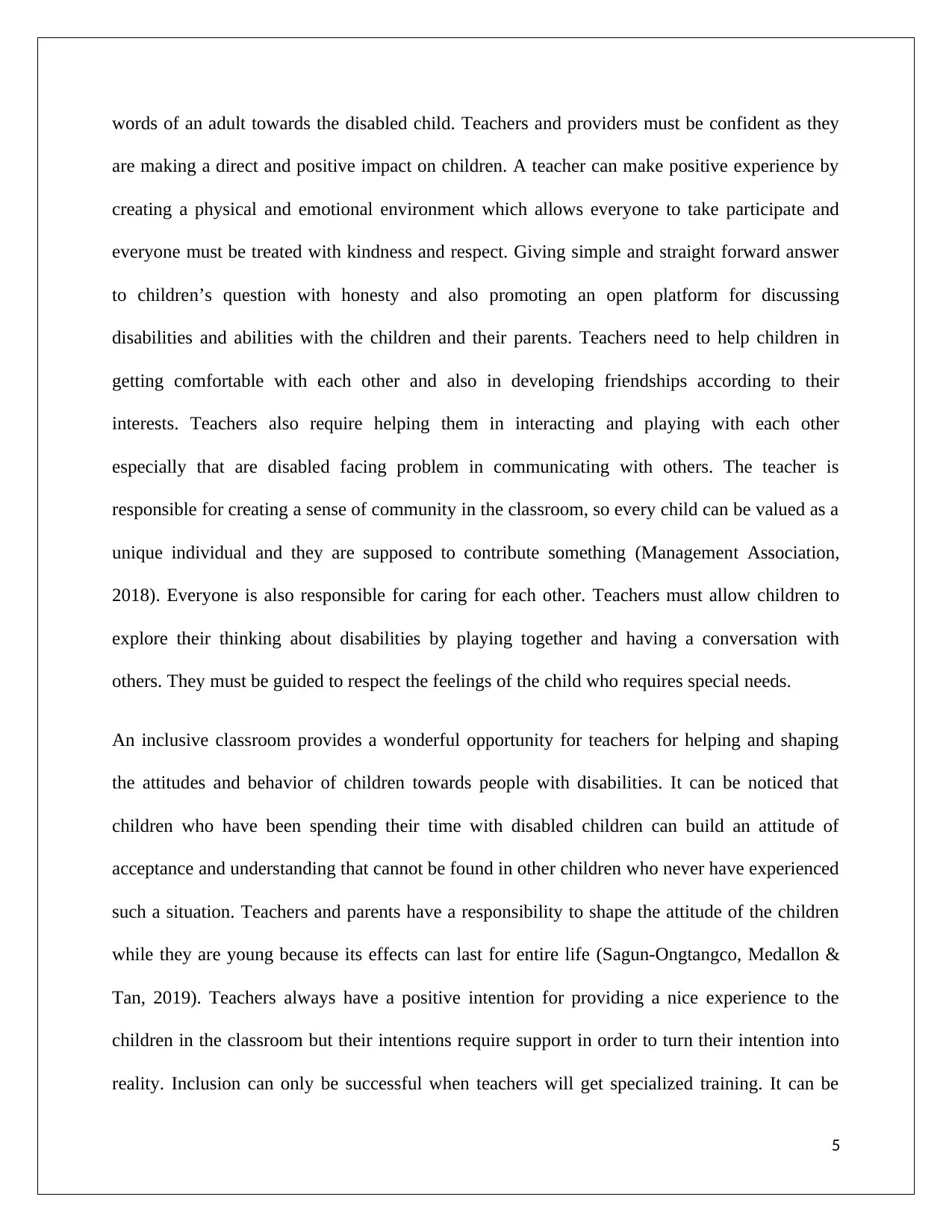
words of an adult towards the disabled child. Teachers and providers must be confident as they
are making a direct and positive impact on children. A teacher can make positive experience by
creating a physical and emotional environment which allows everyone to take participate and
everyone must be treated with kindness and respect. Giving simple and straight forward answer
to children’s question with honesty and also promoting an open platform for discussing
disabilities and abilities with the children and their parents. Teachers need to help children in
getting comfortable with each other and also in developing friendships according to their
interests. Teachers also require helping them in interacting and playing with each other
especially that are disabled facing problem in communicating with others. The teacher is
responsible for creating a sense of community in the classroom, so every child can be valued as a
unique individual and they are supposed to contribute something (Management Association,
2018). Everyone is also responsible for caring for each other. Teachers must allow children to
explore their thinking about disabilities by playing together and having a conversation with
others. They must be guided to respect the feelings of the child who requires special needs.
An inclusive classroom provides a wonderful opportunity for teachers for helping and shaping
the attitudes and behavior of children towards people with disabilities. It can be noticed that
children who have been spending their time with disabled children can build an attitude of
acceptance and understanding that cannot be found in other children who never have experienced
such a situation. Teachers and parents have a responsibility to shape the attitude of the children
while they are young because its effects can last for entire life (Sagun-Ongtangco, Medallon &
Tan, 2019). Teachers always have a positive intention for providing a nice experience to the
children in the classroom but their intentions require support in order to turn their intention into
reality. Inclusion can only be successful when teachers will get specialized training. It can be
5
are making a direct and positive impact on children. A teacher can make positive experience by
creating a physical and emotional environment which allows everyone to take participate and
everyone must be treated with kindness and respect. Giving simple and straight forward answer
to children’s question with honesty and also promoting an open platform for discussing
disabilities and abilities with the children and their parents. Teachers need to help children in
getting comfortable with each other and also in developing friendships according to their
interests. Teachers also require helping them in interacting and playing with each other
especially that are disabled facing problem in communicating with others. The teacher is
responsible for creating a sense of community in the classroom, so every child can be valued as a
unique individual and they are supposed to contribute something (Management Association,
2018). Everyone is also responsible for caring for each other. Teachers must allow children to
explore their thinking about disabilities by playing together and having a conversation with
others. They must be guided to respect the feelings of the child who requires special needs.
An inclusive classroom provides a wonderful opportunity for teachers for helping and shaping
the attitudes and behavior of children towards people with disabilities. It can be noticed that
children who have been spending their time with disabled children can build an attitude of
acceptance and understanding that cannot be found in other children who never have experienced
such a situation. Teachers and parents have a responsibility to shape the attitude of the children
while they are young because its effects can last for entire life (Sagun-Ongtangco, Medallon &
Tan, 2019). Teachers always have a positive intention for providing a nice experience to the
children in the classroom but their intentions require support in order to turn their intention into
reality. Inclusion can only be successful when teachers will get specialized training. It can be
5
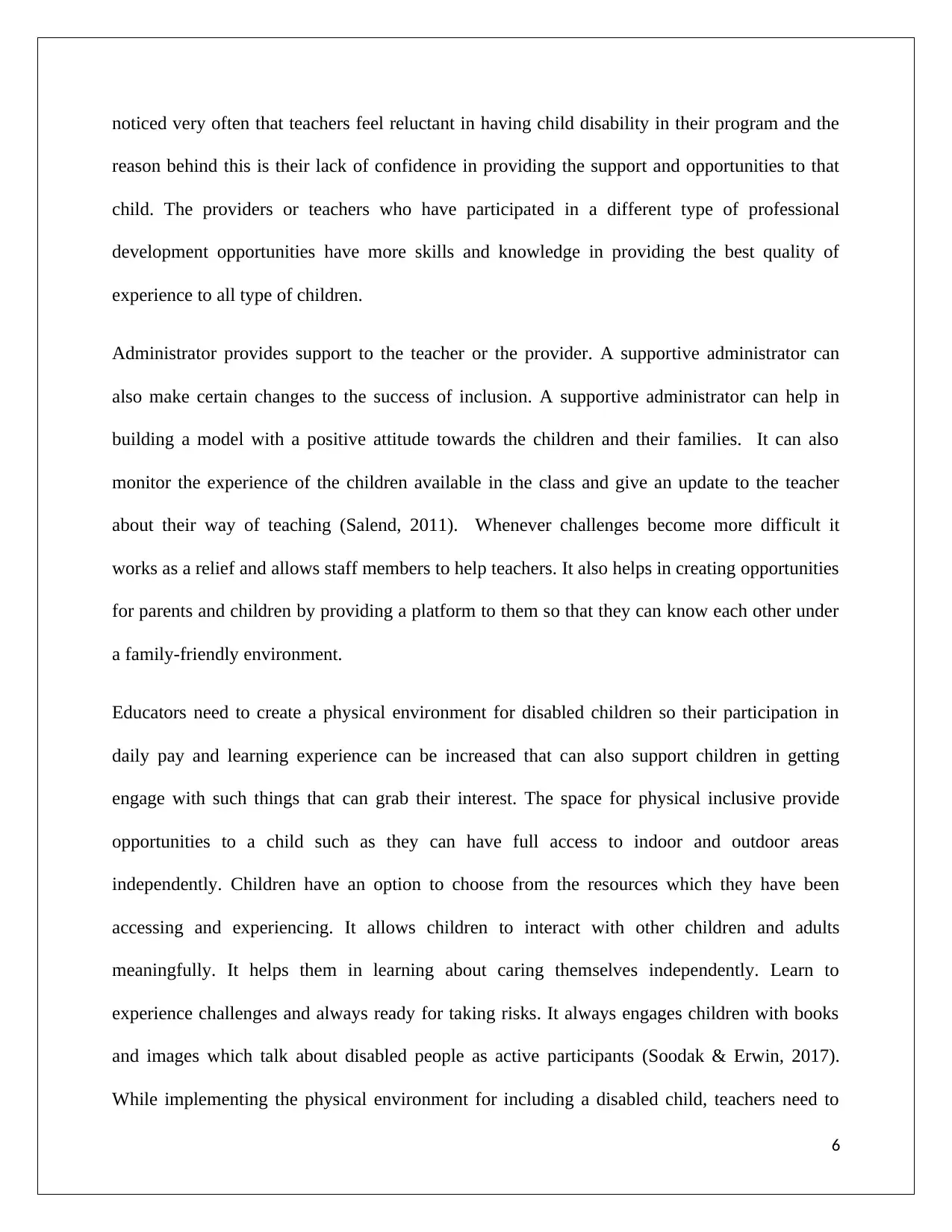
noticed very often that teachers feel reluctant in having child disability in their program and the
reason behind this is their lack of confidence in providing the support and opportunities to that
child. The providers or teachers who have participated in a different type of professional
development opportunities have more skills and knowledge in providing the best quality of
experience to all type of children.
Administrator provides support to the teacher or the provider. A supportive administrator can
also make certain changes to the success of inclusion. A supportive administrator can help in
building a model with a positive attitude towards the children and their families. It can also
monitor the experience of the children available in the class and give an update to the teacher
about their way of teaching (Salend, 2011). Whenever challenges become more difficult it
works as a relief and allows staff members to help teachers. It also helps in creating opportunities
for parents and children by providing a platform to them so that they can know each other under
a family-friendly environment.
Educators need to create a physical environment for disabled children so their participation in
daily pay and learning experience can be increased that can also support children in getting
engage with such things that can grab their interest. The space for physical inclusive provide
opportunities to a child such as they can have full access to indoor and outdoor areas
independently. Children have an option to choose from the resources which they have been
accessing and experiencing. It allows children to interact with other children and adults
meaningfully. It helps them in learning about caring themselves independently. Learn to
experience challenges and always ready for taking risks. It always engages children with books
and images which talk about disabled people as active participants (Soodak & Erwin, 2017).
While implementing the physical environment for including a disabled child, teachers need to
6
reason behind this is their lack of confidence in providing the support and opportunities to that
child. The providers or teachers who have participated in a different type of professional
development opportunities have more skills and knowledge in providing the best quality of
experience to all type of children.
Administrator provides support to the teacher or the provider. A supportive administrator can
also make certain changes to the success of inclusion. A supportive administrator can help in
building a model with a positive attitude towards the children and their families. It can also
monitor the experience of the children available in the class and give an update to the teacher
about their way of teaching (Salend, 2011). Whenever challenges become more difficult it
works as a relief and allows staff members to help teachers. It also helps in creating opportunities
for parents and children by providing a platform to them so that they can know each other under
a family-friendly environment.
Educators need to create a physical environment for disabled children so their participation in
daily pay and learning experience can be increased that can also support children in getting
engage with such things that can grab their interest. The space for physical inclusive provide
opportunities to a child such as they can have full access to indoor and outdoor areas
independently. Children have an option to choose from the resources which they have been
accessing and experiencing. It allows children to interact with other children and adults
meaningfully. It helps them in learning about caring themselves independently. Learn to
experience challenges and always ready for taking risks. It always engages children with books
and images which talk about disabled people as active participants (Soodak & Erwin, 2017).
While implementing the physical environment for including a disabled child, teachers need to
6
⊘ This is a preview!⊘
Do you want full access?
Subscribe today to unlock all pages.

Trusted by 1+ million students worldwide
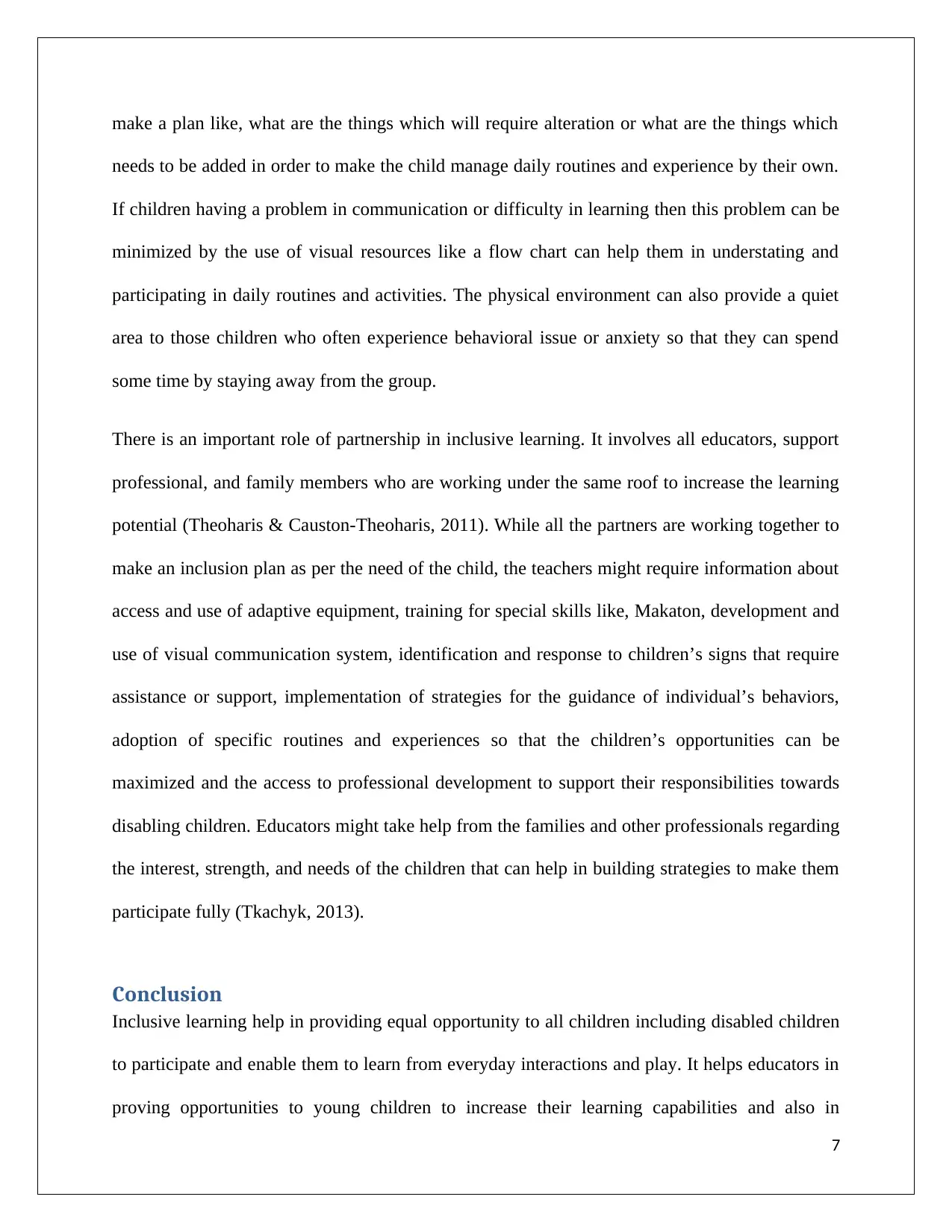
make a plan like, what are the things which will require alteration or what are the things which
needs to be added in order to make the child manage daily routines and experience by their own.
If children having a problem in communication or difficulty in learning then this problem can be
minimized by the use of visual resources like a flow chart can help them in understating and
participating in daily routines and activities. The physical environment can also provide a quiet
area to those children who often experience behavioral issue or anxiety so that they can spend
some time by staying away from the group.
There is an important role of partnership in inclusive learning. It involves all educators, support
professional, and family members who are working under the same roof to increase the learning
potential (Theoharis & Causton‐Theoharis, 2011). While all the partners are working together to
make an inclusion plan as per the need of the child, the teachers might require information about
access and use of adaptive equipment, training for special skills like, Makaton, development and
use of visual communication system, identification and response to children’s signs that require
assistance or support, implementation of strategies for the guidance of individual’s behaviors,
adoption of specific routines and experiences so that the children’s opportunities can be
maximized and the access to professional development to support their responsibilities towards
disabling children. Educators might take help from the families and other professionals regarding
the interest, strength, and needs of the children that can help in building strategies to make them
participate fully (Tkachyk, 2013).
Conclusion
Inclusive learning help in providing equal opportunity to all children including disabled children
to participate and enable them to learn from everyday interactions and play. It helps educators in
proving opportunities to young children to increase their learning capabilities and also in
7
needs to be added in order to make the child manage daily routines and experience by their own.
If children having a problem in communication or difficulty in learning then this problem can be
minimized by the use of visual resources like a flow chart can help them in understating and
participating in daily routines and activities. The physical environment can also provide a quiet
area to those children who often experience behavioral issue or anxiety so that they can spend
some time by staying away from the group.
There is an important role of partnership in inclusive learning. It involves all educators, support
professional, and family members who are working under the same roof to increase the learning
potential (Theoharis & Causton‐Theoharis, 2011). While all the partners are working together to
make an inclusion plan as per the need of the child, the teachers might require information about
access and use of adaptive equipment, training for special skills like, Makaton, development and
use of visual communication system, identification and response to children’s signs that require
assistance or support, implementation of strategies for the guidance of individual’s behaviors,
adoption of specific routines and experiences so that the children’s opportunities can be
maximized and the access to professional development to support their responsibilities towards
disabling children. Educators might take help from the families and other professionals regarding
the interest, strength, and needs of the children that can help in building strategies to make them
participate fully (Tkachyk, 2013).
Conclusion
Inclusive learning help in providing equal opportunity to all children including disabled children
to participate and enable them to learn from everyday interactions and play. It helps educators in
proving opportunities to young children to increase their learning capabilities and also in
7
Paraphrase This Document
Need a fresh take? Get an instant paraphrase of this document with our AI Paraphraser
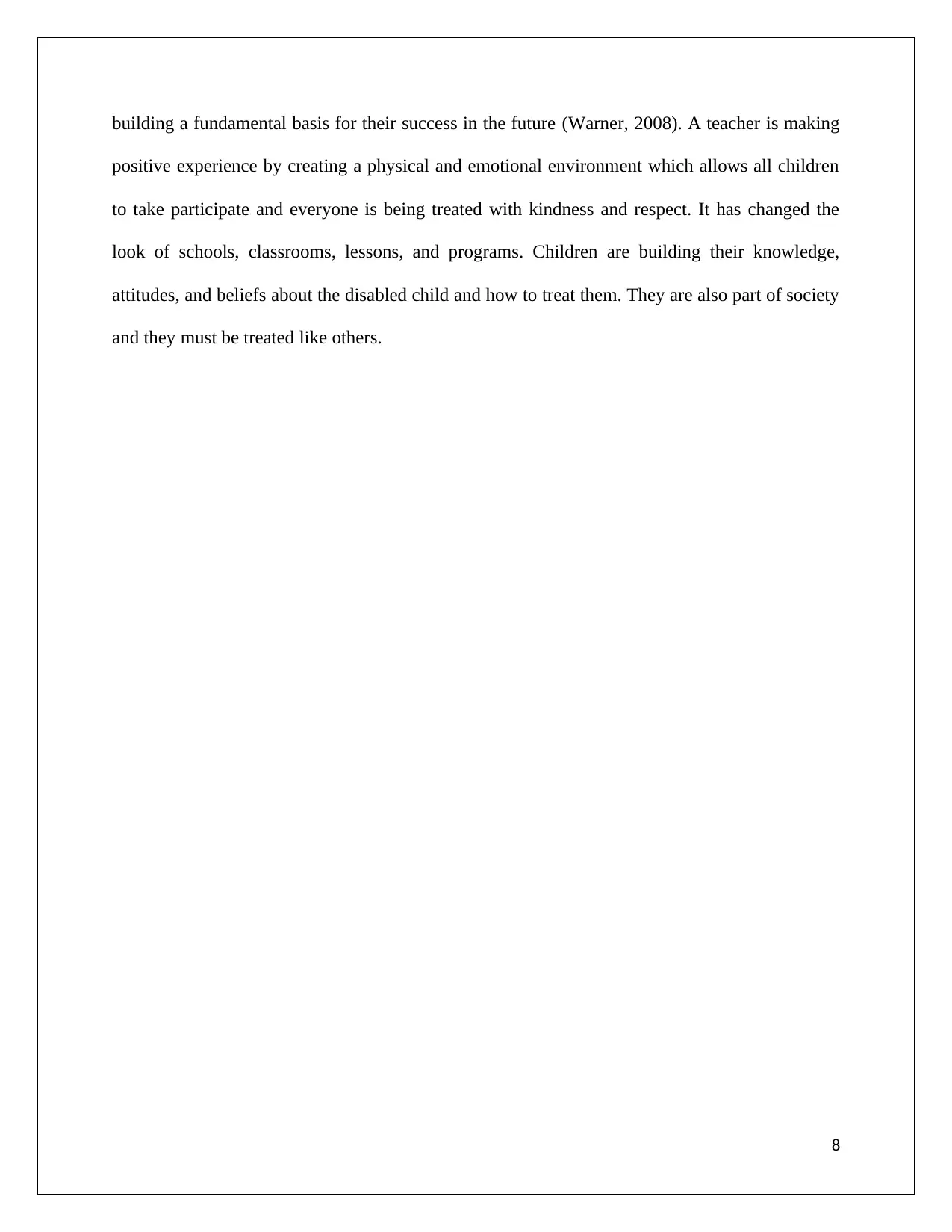
building a fundamental basis for their success in the future (Warner, 2008). A teacher is making
positive experience by creating a physical and emotional environment which allows all children
to take participate and everyone is being treated with kindness and respect. It has changed the
look of schools, classrooms, lessons, and programs. Children are building their knowledge,
attitudes, and beliefs about the disabled child and how to treat them. They are also part of society
and they must be treated like others.
8
positive experience by creating a physical and emotional environment which allows all children
to take participate and everyone is being treated with kindness and respect. It has changed the
look of schools, classrooms, lessons, and programs. Children are building their knowledge,
attitudes, and beliefs about the disabled child and how to treat them. They are also part of society
and they must be treated like others.
8

References
Carnevale, A. (2012). Healthcare (2nd ed.). Washington, D.C.: Georgetown
University, Georgetown Public Poicy Institute, Center on Education and the
Workforce.
Gigante, J., & Gilmore, L. (2018). Australian preservice teachers’ attitudes and
perceived efficacy for teaching in inclusive classrooms. International Journal Of
Inclusive Education, 1-10. doi: 10.1080/13603116.2018.1545875
King-Sears, M. (2017). Best Academic Practices for Inclusive Classrooms. Focus On
Exceptional Children, 29(7). doi: 10.17161/foec.v29i7.6753
Land, S. (2010). Effective Teaching Practices for Students in Inclusive Classrooms.
Management Association, I. (2018). Teacher Training and Professional
Development (5th ed.). Hershey: IGI Global.
Sagun-Ongtangco, K., Medallon, K., & Tan, A. (2019). Inclusive classrooms: making
it work for peers of children with disability. International Journal Of Inclusive
Education, 1-17. doi: 10.1080/13603116.2019.1568596
Salend, S. (2011). Creating inclusive classrooms (4th ed.). Boston: Pearson.
Soodak, L., & Erwin, E. (2017). Inclusive Education-Article (1st ed.). City University
of New York.
Theoharis, G., & Causton‐Theoharis, J. (2011). Preparing pre‐service teachers for
inclusive classrooms: revising lesson‐planning expectations. International
Journal Of Inclusive Education, 15(7), 743-761. doi:
10.1080/13603110903350321
Tkachyk, R. (2013). Questioning Secondary Inclusive Education: Are Inclusive
Classrooms Always Best for Students?. Interchange, 44(1-2), 15-24. doi:
10.1007/s10780-013-9193-z
Warner, L. (2008). Themes for inclusive classrooms (2nd ed.). Beltsville, MD:
Gryphon House.
9
Carnevale, A. (2012). Healthcare (2nd ed.). Washington, D.C.: Georgetown
University, Georgetown Public Poicy Institute, Center on Education and the
Workforce.
Gigante, J., & Gilmore, L. (2018). Australian preservice teachers’ attitudes and
perceived efficacy for teaching in inclusive classrooms. International Journal Of
Inclusive Education, 1-10. doi: 10.1080/13603116.2018.1545875
King-Sears, M. (2017). Best Academic Practices for Inclusive Classrooms. Focus On
Exceptional Children, 29(7). doi: 10.17161/foec.v29i7.6753
Land, S. (2010). Effective Teaching Practices for Students in Inclusive Classrooms.
Management Association, I. (2018). Teacher Training and Professional
Development (5th ed.). Hershey: IGI Global.
Sagun-Ongtangco, K., Medallon, K., & Tan, A. (2019). Inclusive classrooms: making
it work for peers of children with disability. International Journal Of Inclusive
Education, 1-17. doi: 10.1080/13603116.2019.1568596
Salend, S. (2011). Creating inclusive classrooms (4th ed.). Boston: Pearson.
Soodak, L., & Erwin, E. (2017). Inclusive Education-Article (1st ed.). City University
of New York.
Theoharis, G., & Causton‐Theoharis, J. (2011). Preparing pre‐service teachers for
inclusive classrooms: revising lesson‐planning expectations. International
Journal Of Inclusive Education, 15(7), 743-761. doi:
10.1080/13603110903350321
Tkachyk, R. (2013). Questioning Secondary Inclusive Education: Are Inclusive
Classrooms Always Best for Students?. Interchange, 44(1-2), 15-24. doi:
10.1007/s10780-013-9193-z
Warner, L. (2008). Themes for inclusive classrooms (2nd ed.). Beltsville, MD:
Gryphon House.
9
⊘ This is a preview!⊘
Do you want full access?
Subscribe today to unlock all pages.

Trusted by 1+ million students worldwide
1 out of 9
Related Documents
Your All-in-One AI-Powered Toolkit for Academic Success.
+13062052269
info@desklib.com
Available 24*7 on WhatsApp / Email
![[object Object]](/_next/static/media/star-bottom.7253800d.svg)
Unlock your academic potential
Copyright © 2020–2025 A2Z Services. All Rights Reserved. Developed and managed by ZUCOL.




